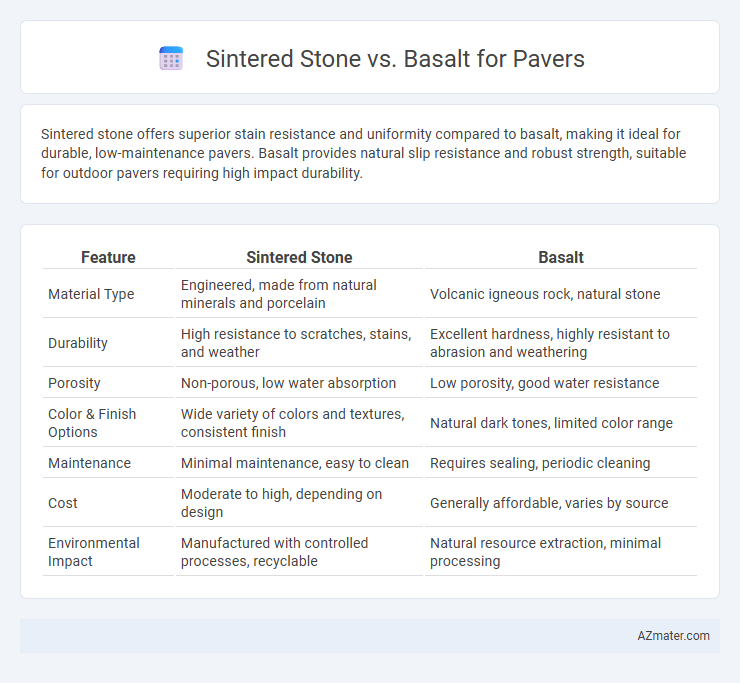Sintered stone offers superior stain resistance and uniformity compared to basalt, making it ideal for durable, low-maintenance pavers. Basalt provides natural slip resistance and robust strength, suitable for outdoor pavers requiring high impact durability.
Table of Comparison
| Feature | Sintered Stone | Basalt |
|---|---|---|
| Material Type | Engineered, made from natural minerals and porcelain | Volcanic igneous rock, natural stone |
| Durability | High resistance to scratches, stains, and weather | Excellent hardness, highly resistant to abrasion and weathering |
| Porosity | Non-porous, low water absorption | Low porosity, good water resistance |
| Color & Finish Options | Wide variety of colors and textures, consistent finish | Natural dark tones, limited color range |
| Maintenance | Minimal maintenance, easy to clean | Requires sealing, periodic cleaning |
| Cost | Moderate to high, depending on design | Generally affordable, varies by source |
| Environmental Impact | Manufactured with controlled processes, recyclable | Natural resource extraction, minimal processing |
Introduction to Sintered Stone and Basalt
Sintered stone is an engineered material made by compacting natural minerals under high heat and pressure, offering exceptional durability, resistance to scratches, and UV stability, ideal for pavers in high-traffic areas. Basalt, a natural volcanic rock, is renowned for its dense composition, hardness, and natural slip resistance, making it a popular choice for outdoor paving applications exposed to varying weather conditions. Both materials provide durability and aesthetics, but sintered stone offers more uniformity and customizability, while basalt benefits from unique natural textures and superior thermal conductivity.
Material Composition and Formation
Sintered stone is an engineered material composed of natural minerals fused under extreme heat and pressure, resulting in a non-porous, uniform surface ideal for pavers. Basalt, a volcanic igneous rock, forms from the rapid cooling of lava, exhibiting high density and natural durability with a crystalline texture. The controlled manufacturing of sintered stone offers consistent composition and enhanced weather resistance compared to the naturally variable mineral makeup of basalt.
Appearance and Design Versatility
Sintered stone offers a wide range of colors, patterns, and textures that closely mimic natural materials like marble and granite, making it highly versatile for contemporary and classic paver designs. Basalt, characterized by its dark, uniform coloration and volcanic texture, provides a sleek, minimalist aesthetic ideal for modern landscaping. While sintered stone allows for greater customization in appearance and can incorporate intricate designs, basalt excels in durability and maintains a consistent natural look that complements minimalist architecture.
Durability and Strength Comparison
Sintered stone offers exceptional durability with high resistance to scratches, stains, and weathering due to its manufacturing process involving compacted minerals at extreme heat and pressure. Basalt, a natural volcanic rock, is known for its impressive compressive strength and resistance to abrasion, making it a robust choice for heavy traffic areas. While basalt provides natural strength, sintered stone combines both strength and enhanced surface durability, often outperforming basalt in long-term wear and environmental resilience for pavers.
Weather Resistance and Performance Outdoors
Sintered stone exhibits superior weather resistance for outdoor pavers due to its low porosity and high density, preventing water absorption and frost damage in extreme climates. Basalt offers excellent durability and natural resistance to wear and temperature fluctuations but may absorb moisture over time, potentially leading to surface degradation in freeze-thaw conditions. Both materials perform well outdoors, but sintered stone's engineered composition enhances long-term performance against UV exposure, chemical stains, and thermal shock.
Slip Resistance and Safety
Sintered stone offers superior slip resistance due to its highly textured surface and dense composition, making it an ideal choice for safe, non-slip paver applications. Basalt, while naturally durable and possessing moderate slip resistance, often requires additional treatments or finishes to enhance its safety performance in wet or high-traffic areas. The maintenance and surface texture of sintered stone significantly reduce slip hazards, providing a safer environment for pedestrian walkways compared to untreated basalt pavers.
Installation Process and Maintenance
Sintered stone offers a lightweight, easy-to-handle option for paver installation, requiring minimal adhesive and reducing labor time compared to basalt's heavier slabs that often need mechanical fastening or specialized cutting tools. Basalt's natural porosity demands sealing and periodic maintenance to prevent staining and erosion, while sintered stone's non-porous surface resists stains and weathering, significantly lowering upkeep requirements. Both materials benefit from professional installation to ensure durability, but sintered stone provides greater efficiency and long-term cost savings through simpler maintenance protocols.
Eco-Friendliness and Sustainability
Sintered stone pavers offer eco-friendly benefits through their production process, which utilizes natural raw materials and recycles waste, minimizing environmental impact. Basalt, a natural volcanic rock, is sustainably sourced but requires significant energy for quarrying and processing, potentially increasing its carbon footprint. Both materials provide durability and longevity, reducing the need for frequent replacement and contributing to sustainable paving solutions.
Cost Comparison and Value for Money
Sintered stone tends to have a higher initial cost than basalt due to its advanced manufacturing process, but offers superior durability and stain resistance, often resulting in lower maintenance expenses over time. Basalt, while more affordable upfront, may require more frequent upkeep and has limited color and texture options compared to sintered stone. When evaluating value for money, sintered stone delivers long-term cost efficiency and aesthetic versatility, making it a preferred choice for high-traffic or premium paver applications.
Which is Best for Paver Applications?
Sintered stone offers superior durability, stain resistance, and uniformity, making it an excellent choice for high-traffic paver applications requiring a sleek, modern look. Basalt, a natural volcanic rock, provides exceptional hardness and slip resistance, ideal for outdoor pavers exposed to weather and heavy loads. For paver applications demanding low maintenance and design versatility, sintered stone is often preferred, while basalt excels in rugged, natural environments needing robust performance.

Infographic: Sintered stone vs Basalt for Paver
 azmater.com
azmater.com